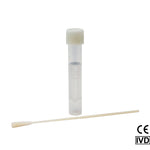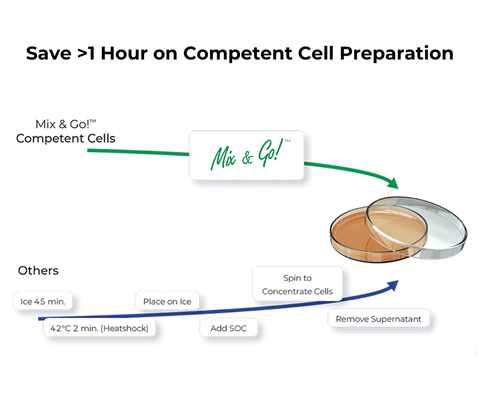Successfully Added to Cart
Customers also bought...
-
 DNA/RNA Shield (50 ml)Cat#: R1100-50DNA/RNA Shield reagent is a DNA and RNA stabilization solution for nucleic acids in any biological sample. This DNA and RNA stabilization solution preserves the...
DNA/RNA Shield (50 ml)Cat#: R1100-50DNA/RNA Shield reagent is a DNA and RNA stabilization solution for nucleic acids in any biological sample. This DNA and RNA stabilization solution preserves the... -
 DNA/RNA Shield SafeCollect Swab Collection Kit, 1ml (1 collection kit)Cat#: R1160The DNA/RNA Shield SafeCollect Swab Collection Kit is a user-friendly collection kit for stabilizing the nucleic acid content of samples collected with a swab. DNA/RNA Shield completely inactivates harmful pathogens...
DNA/RNA Shield SafeCollect Swab Collection Kit, 1ml (1 collection kit)Cat#: R1160The DNA/RNA Shield SafeCollect Swab Collection Kit is a user-friendly collection kit for stabilizing the nucleic acid content of samples collected with a swab. DNA/RNA Shield completely inactivates harmful pathogens...
Mix & Go! Competent Cells - DH5 Alpha
| Cat # | Name | Size | Price | Quantity |
|---|
Highlights
- Simple 20 Second Transformation: No heat shock! Just add DNA and spread on plate.
- High Transformation Efficiencies: Achieve 108 - 109 per µg of plasmid DNA.
- Versatile: Excellent for general cloning, blue-white screening, and plasmid isolation.
Documents
Product Description
Technical Specifications
| Additional Info | Insert stability due to recA1 mutation. Can be used for blue/white screening, accepts large plasmids due to deoR mutation. High plasmid yield due to endA1 mutation. |
|---|---|
| Genotype | F-Φ80lacZΔM15 Δ(lacZYA-argF)U169 deoR nupG recA1 endA1 hsdR17(rK- mK+) phoA glnV44 (supE44) thi-1 gyrA96 relA1,λ- |
| Processing Time | 20 Seconds |
| Product Storage | -70°C to -80°C |
| Transformation Efficiency | 108 - 109 transformants per µg of plasmid DNA |
Resources
Q1: Are competent cells GMOs?
All our competent cells are classified into Biosafety level 1 and are not genetic modified organisms. Only when transformed with a plasmid they become GMOs.
Q2: Are the Mix & Go! strains dam+ and dcm+?
Most cloning strains will be dam+/dcm+ unless specifically noted in the genotype.
Q3: Do the Mix & Go! strains methylate DNA?
Yes
Q4: Which strains are equivalent to the Zymo strains?
DH5α is equivalent to Zymo 5α. DH10B, Top10, and One Shot Top10 are equivalent to Zymo 10B. For XL-21 Blue, JM109 is the closest match and for Stbl3, HB101 is the closest match.
Q5: How to reduce satellite colonies on agar plates?
– Prepare fresh agar plates – Use more antibiotics in plates – Incubate plates for a shorter time after plating cells
Q6: Is it possible to dilute the competent cells?
We do not recommend diluting the competent cells. We recommend using less DNA to transform cells, or aliquot cells in smaller volumes before transformation. If absolutely necessary, cold 1X Competent Buffer (Mix & Go Transformation Kit, T3001 & T3002) should be used in the dilution.
Q7: Which antibiotics can be used with the Mix & Go! procedure?
No outgrowth is necessary when using Ampicillin or Carbenicillin for selection. However, an outgrowth step is required when using Chloramphenicol, Kanamycin, and Tetracycline because of the mode of action of the antibiotic itself. We recommend the following procedure for the outgrowth step: 1. Incubate cells on ice for 5-10 min after addition of plasmid. 2. Add 4 volumes of SOC media. 3. Incubate at 37°C for 60 min with gentle shaking at 200-300 rpm. 4. Spread on a pre-warmed culture plate containing the appropriate antibiotic.
Q8: Which Plasmid Size can be used for transformation?
For Zymo 5α and Zymo 10B up to 20kb. However, transformation efficiency decreases proportionally from 10-20kb. Above 20kb, cells are difficult to transform. JM109, HB101, XJa, XJa (DE3), XJb, XJb (DE3) and TG1 can handle constructs up to 10kb.
Q9: Which is the recommended DNA concentration and volume for transformation?
There really is no maximum or minimum recommended DNA concentration, but we use 10 pg for quality control. However, the volume of DNA added should not exceed 5% of the cells total volume; the efficiency can decrease several fold as the volume of DNA used increases. If the DNA sample is too diluted, use our DNA Clean & Concentrator.
Q10: What are some tips to improve transformation efficiency?
1. Thaw cells on ice, not room temperature. 2. Incubate cells and DNA mixture on ice, not at room temperature. However, do not incubate longer then 1 hour. 3. Ensure cells are still frozen when received. 4. Pre-warm the culture plates at 37°C for at least 30 minutes. 5. Prepare fresh LB agar plates containing the appropriate antibiotic. 6. Prepare a new DNA sample. 7. Store the cells at -80°C (not 4°C or -20°C). If the freezer breaks, the cells should be OK as long as the temp does not go higher than -50°C. 8. Avoid freeze/thaw cycles.
Q11: How will a heat-shock affect my Transformation Efficiency?
Heat shock is not necessary, however sometimes it can be beneficiary when preparing libraries or transforming XJb Autolysis E. coli strains. We recommend the following protocol for Heat Shock with Outgrowth: 1. Incubate cells on ice for 5-10 min after addition of plasmid. 2. Incubate cells at 42°C for 45 seconds. 3. Add 450 ml of SOC to the cells. 4. Incubate at 37°C for 60 min with gentle shaking at 200-300 rpm. 5. Spread on a pre-warmed culture plate containing the appropriate antibiotic.
"It saves time and money and it really works! I chose this kit because it was regularly used by the people at Addgene.com. It is really easy to make and the transfection efficiency is higher than what I would get from the homemade competent cells. The feature that I like the most about this kit is that it takes less than 5 min to perform the whole transformation procedure (with ampicillin as a selection marker) instead of a regular 1.30 H!"
Cho R.
Michigan State University
"Worth the price. Great transformation efficiency, save so much time from the traditional transformation protocol, awesome price and last forever. Thanks!"
Yu L.
Caltech
"The fastest competent cells. Revolutionary! No need to care for the delicate transfection of your E.coli, Mix&Go has shortened the process from 2h to 5min. Simply add a few microliters of your plasmid on ice, wait 5min, Voila!"
Jerome B
UCSF
Need help? Contact Us





